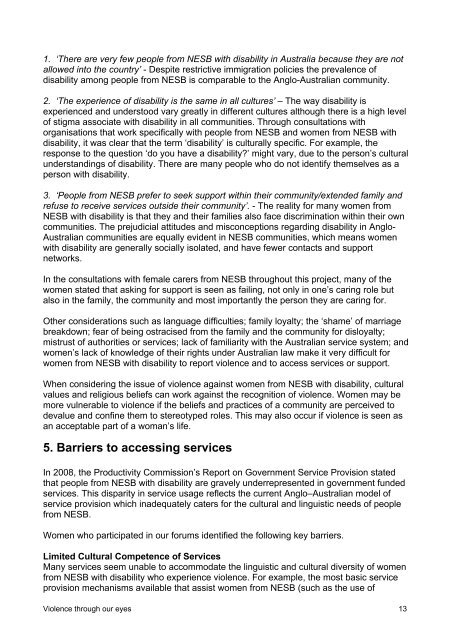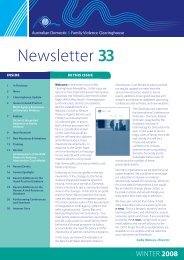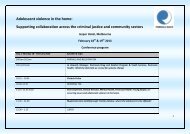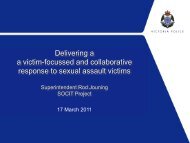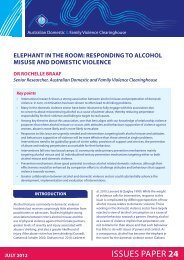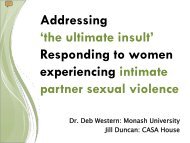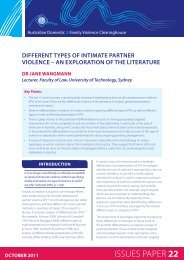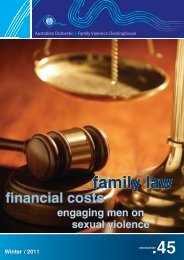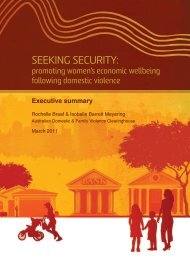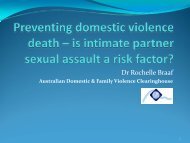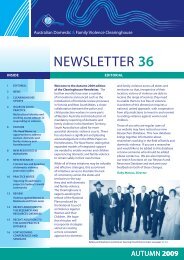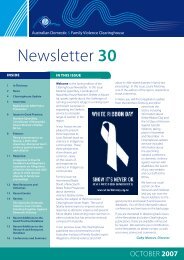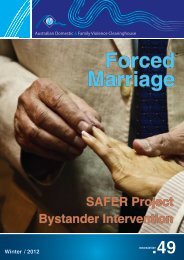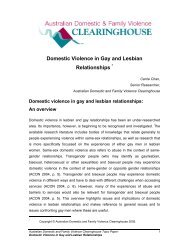Violence through our eyes - Women With Disabilities Australia
Violence through our eyes - Women With Disabilities Australia
Violence through our eyes - Women With Disabilities Australia
You also want an ePaper? Increase the reach of your titles
YUMPU automatically turns print PDFs into web optimized ePapers that Google loves.
1. ‘There are very few people from NESB with disability in <strong>Australia</strong> because they are not<br />
allowed into the country’ - Despite restrictive immigration policies the prevalence of<br />
disability among people from NESB is comparable to the Anglo-<strong>Australia</strong>n community.<br />
2. ‘The experience of disability is the same in all cultures’ – The way disability is<br />
experienced and understood vary greatly in different cultures although there is a high level<br />
of stigma associate with disability in all communities. Through consultations with<br />
organisations that work specifically with people from NESB and women from NESB with<br />
disability, it was clear that the term ‘disability’ is culturally specific. For example, the<br />
response to the question ‘do you have a disability’ might vary, due to the person’s cultural<br />
understandings of disability. There are many people who do not identify themselves as a<br />
person with disability.<br />
3. ‘People from NESB prefer to seek support within their community/extended family and<br />
refuse to receive services outside their community’. - The reality for many women from<br />
NESB with disability is that they and their families also face discrimination within their own<br />
communities. The prejudicial attitudes and misconceptions regarding disability in Anglo-<br />
<strong>Australia</strong>n communities are equally evident in NESB communities, which means women<br />
with disability are generally socially isolated, and have fewer contacts and support<br />
networks.<br />
In the consultations with female carers from NESB <strong>through</strong>out this project, many of the<br />
women stated that asking for support is seen as failing, not only in one’s caring role but<br />
also in the family, the community and most importantly the person they are caring for.<br />
Other considerations such as language difficulties; family loyalty; the ‘shame’ of marriage<br />
breakdown; fear of being ostracised from the family and the community for disloyalty;<br />
mistrust of authorities or services; lack of familiarity with the <strong>Australia</strong>n service system; and<br />
women’s lack of knowledge of their rights under <strong>Australia</strong>n law make it very difficult for<br />
women from NESB with disability to report violence and to access services or support.<br />
When considering the issue of violence against women from NESB with disability, cultural<br />
values and religious beliefs can work against the recognition of violence. <strong>Women</strong> may be<br />
more vulnerable to violence if the beliefs and practices of a community are perceived to<br />
devalue and confine them to stereotyped roles. This may also occur if violence is seen as<br />
an acceptable part of a woman’s life.<br />
5. Barriers to accessing services<br />
In 2008, the Productivity Commission’s Report on Government Service Provision stated<br />
that people from NESB with disability are gravely underrepresented in government funded<br />
services. This disparity in service usage reflects the current Anglo–<strong>Australia</strong>n model of<br />
service provision which inadequately caters for the cultural and linguistic needs of people<br />
from NESB.<br />
<strong>Women</strong> who participated in <strong>our</strong> forums identified the following key barriers.<br />
Limited Cultural Competence of Services<br />
Many services seem unable to accommodate the linguistic and cultural diversity of women<br />
from NESB with disability who experience violence. For example, the most basic service<br />
provision mechanisms available that assist women from NESB (such as the use of<br />
<strong>Violence</strong> <strong>through</strong> <strong>our</strong> <strong>eyes</strong> 13


